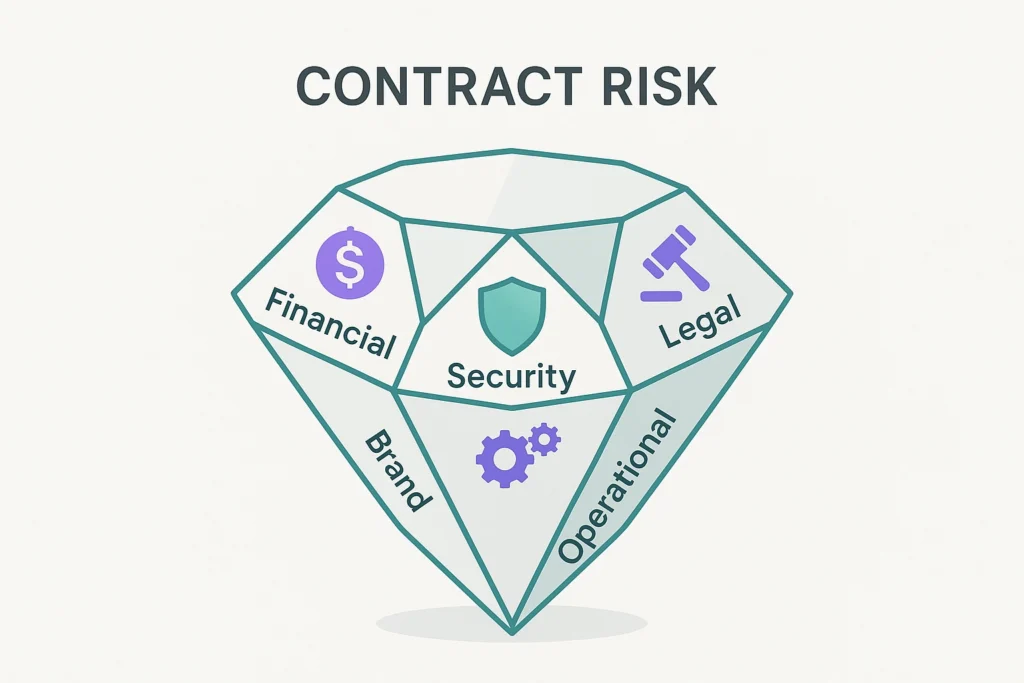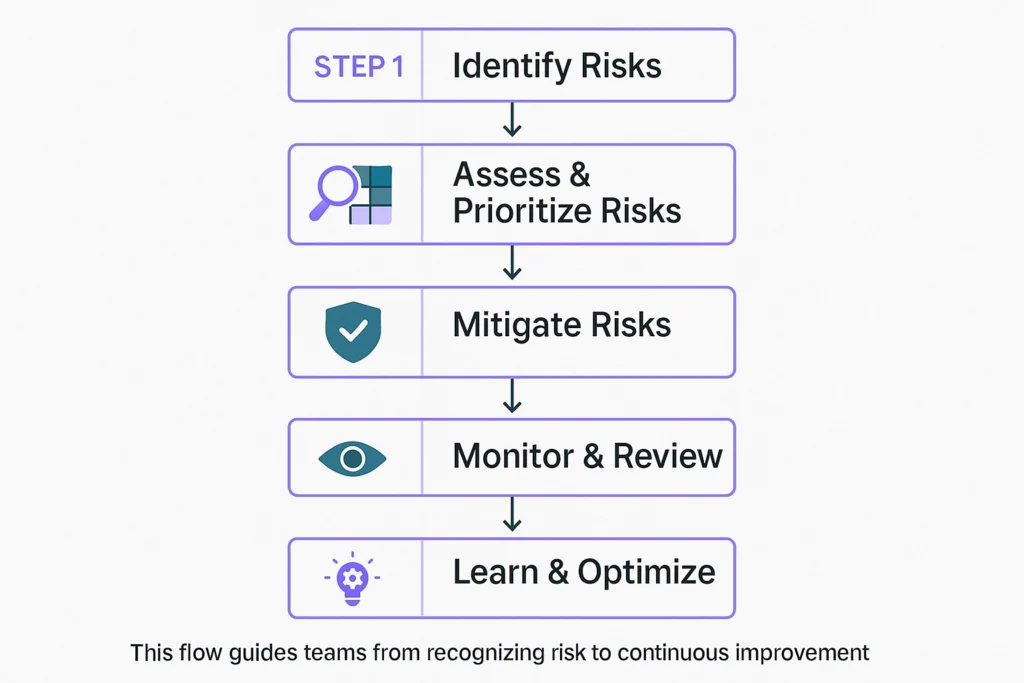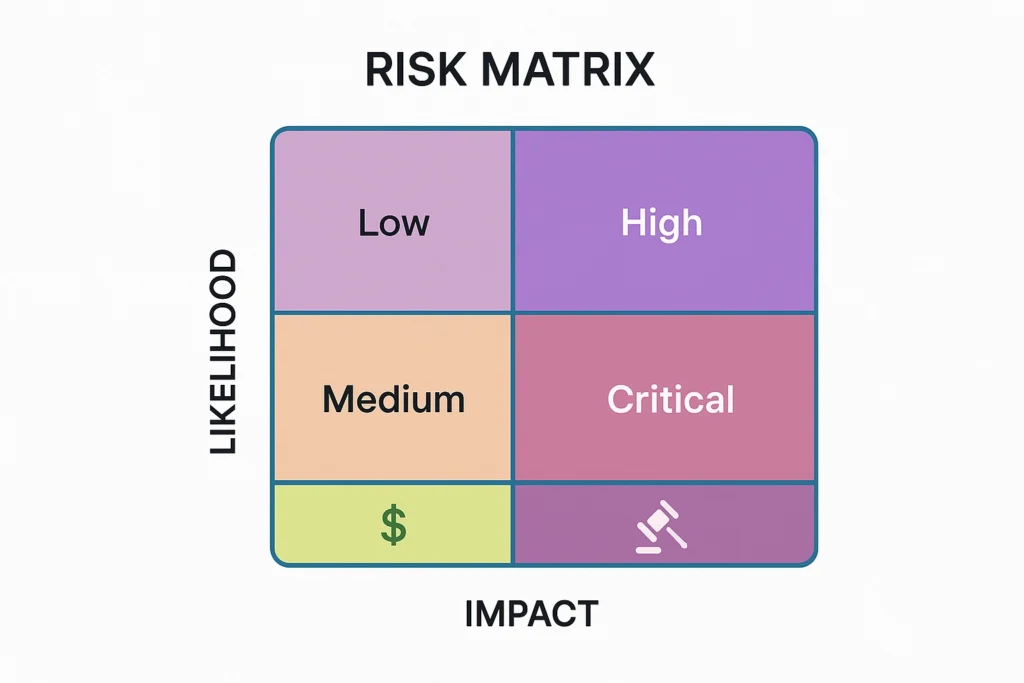Understanding Contract Risk: A Complete Guide for Enterprise Legal and Procurement Teams

- Last Updated: Nov 21, 2025
- 15 min read
- Arpita Chakravorty
Ever signed a contract and felt a tiny bit of unease, wondering what you might have missed? Maybe it was a vendor agreement, a new client deal, or a software subscription. On the surface, everything looked fine. But deep down, you had a nagging feeling about the dense legal text, the vague deadlines, or the clauses you didn’t quite understand.
That feeling has a name: contract risk. It’s the hidden danger in every deal, the possibility that the document designed to protect you could actually lead to financial loss, operational disruption, or damage to your company’s reputation. But here’s the good news: you don’t have to be a lawyer to understand it, and you certainly don’t have to be a victim of it.
What Exactly Is Contract Risk? (And Why It’s Not Just for Lawyers)
So, what are we really talking about when we say “contract risk”? At its core, contract risk is any potential for negative consequences that arises from a contract you’ve entered into. It’s the gap between the value you expect to get from a deal and the value you actually realize. Think of it less as a legal abstraction and more as a critical business issue that can impact everything from your budget to your brand.
The first step in taming this risk is understanding its different forms. While every contract is unique, the potential pitfalls generally fall into a few key categories that work together.
Before we categorize risk, it’s worth asking—how does it slip into contracts in the first place?
Common Causes of Contract Risk
Even the best-intentioned agreements can carry hidden pitfalls. In our work with enterprises, we see risk most often stemming from:
- Outdated templates that fail to reflect current regulations or business realities.
- Siloed processes where legal, procurement, and business teams work in isolation.
- Over-reliance on “copy-paste” clauses without context-specific review.
- Poor vendor due diligence, leading to partnerships with compliance or delivery issues.
- Limited visibility into active obligations, renewals, or dependencies.
Spotting these triggers early makes it easier to address them before they escalate into real exposure.
Types of Risk in Contract Management

Here are the primary types of risks in contract management that you should be aware of:
- Financial Risk: This is the most obvious threat, involving direct monetary loss from things like unexpected price hikes, missed renewal deadlines that trigger penalties, or incorrect invoices that go unchecked.
- Legal & Compliance Risk: This risk arises from failing to meet legal, regulatory, or contractual obligations, potentially leading to fines, lawsuits, or the invalidation of the entire agreement.
- Security Risk: In an increasingly digital world, this involves inadequate data protection clauses that could lead to breaches, compromising sensitive company or customer information.
- Operational Risk: This is the risk that a contract disrupts your day-to-day business, such as a supplier failing to deliver on time or a service not meeting the agreed-upon quality standards.
- Brand & Reputational Risk: This involves damage to your company’s public image, which could happen if you partner with a vendor who has unethical practices or fails to deliver on promises to your end customers.
Explore the Types of Risks in Contract Management to understand where vulnerabilities hide—and how to address them before they escalate.
These categories come alive when you see how they play out in day-to-day business.
Real-Life Examples of Contract Risk in Action
- Financial Risk: A missed SaaS renewal deadline triggers an auto-renewal at a 25% higher rate, eating into annual budgets.
- Compliance Risk: A vendor stores EU customer data outside GDPR-compliant servers, leading to regulatory investigation.
- Operational Risk: A supplier fails to deliver raw materials on time, halting production for weeks.
- Reputational Risk: A subcontractor’s unethical practices surface in the media, damaging your brand by association.
These aren’t hypothetical—they’re scenarios many organizations face without the right safeguards.
Are You Managing Contract Risk, or Just Hoping for the Best? The 5-Step Framework
Leaving contract risk to chance is like navigating a ship through a storm without a map. You might get lucky, but the odds are not in your favor. A proactive, structured approach is the only way to steer clear of the hazards. A strong contract risk management process transforms uncertainty into a manageable and predictable system.
The good news is that this process isn’t overly complicated. It can be broken down into five clear, logical steps that create a continuous cycle of improvement.

Let’s walk through the entire contract lifecycle management process from a risk perspective.
Step 1: Identify Potential Hazards
You can’t manage a risk you don’t know exists. This first step is all about discovery. It involves thoroughly reviewing a contract to spot potential problems before they materialize.
Are there ambiguous terms? Vague responsibilities? Unfavorable auto-renewal clauses? Are the obligations for both parties crystal clear? This stage requires a careful contract review process to ensure nothing slips through the cracks. A common mistake here is using outdated templates that don’t reflect current laws or business needs.
Step 2: Assess and Prioritize the Dangers
Not all risks are created equal. A typo in a non-critical section is an inconvenience; a missing limitation of liability clause is a potential catastrophe. The goal here is to evaluate each identified risk based on two factors: its potential impact on your business and the likelihood of it occurring. This helps you focus your energy on the threats that matter most instead of getting bogged down by minor issues.
Step 3: Create Your Defense Plan (Mitigation)
Once you know which risks are most significant, it’s time to do something about them. Mitigation is the action part of the plan. This can take many forms, such as:
- Negotiating to remove or revise unfavorable terms.
- Clarifying ambiguous language to ensure everyone is on the same page.
- Inserting specific, protective language, like indemnity or confidentiality clauses.
- Purchasing insurance to cover potential losses.
Sometimes, if a risk is too great, the best mitigation strategy is to walk away from the deal entirely.
Having a library of pre-approved, important contract clauses can streamline this step and ensure consistent protection across all agreements.
A strong defense often starts with the right language in the contract itself.
Key Clauses That Keep Risk in Check
Some clauses act as built-in safety nets:
- Limitation of Liability – Caps the maximum exposure in case of disputes.
- Termination for Convenience/Cause – Allows you to exit without prohibitive penalties.
- Force Majeure – Protects against unforeseeable disruptions.
- Indemnification – Transfers certain risks to the other party.
- Confidentiality & Data Protection – Shields sensitive information from misuse.
- Audit Rights – Gives you the ability to verify compliance on demand.
Embedding these consistently—preferably via pre-approved clause libraries—reduces negotiation time while strengthening your position.
Step 4: Keep a Watchful Eye (Monitoring)
A contract is a living document, and risk management doesn’t stop once the ink is dry. The monitoring phase is crucial for managing post-signature risk. This means tracking key dates, obligations, and performance metrics to ensure both parties are holding up their end of the bargain. Are deadlines being met? Are service levels adequate? Modern tools are even capable of automating contract risk detection, sending alerts for upcoming renewals or missed obligations.
Step 5: Learn and Improve for Next Time
The final step is to turn insight into foresight. After a contract is completed or terminated, take the time to review its performance. What went right? What went wrong? Which risks materialized, and how effective were your mitigation strategies? The lessons learned from one contract can be used to refine your process, update your templates, and make you smarter for the next negotiation.
Dive deeper into Contract Risk Management to see how a structured approach can safeguard every stage of your agreements.
Putting It All Together: From Theory to Action
Understanding the framework is one thing; putting it into practice is another. The biggest leap forward for most organizations is moving from a scattered, chaotic approach to a centralized and strategic one.
A major source of unmanaged risk is “rogue contracting”—when employees outside of legal or procurement enter into agreements using unapproved templates or no process at all. The single most effective way to combat this is by establishing a central what is a contract repository. This secure, searchable system acts as the single source of truth for all agreements, providing visibility and control where there was once chaos.
With visibility in place, you can begin to implement a cohesive contract management strategy. This involves using tools like a Risk Matrix to visually prioritize threats, helping your team make smarter, data-driven decisions about where to focus their efforts.

If you can measure it, you can improve it—and contract risk is no exception.
KPIs That Keep Risk Management Accountable
To know whether your risk management process is working, you need clear, measurable indicators. These KPIs track both preventive efforts and the speed of response:
- % of contracts reviewed before signature – Shows how effectively you’re catching risks early in the lifecycle.
- Average time to detect and resolve a risk – Indicates the agility of your monitoring and remediation processes.
- Number of missed obligations per quarter – Highlights operational gaps that could lead to penalties or strained relationships.
- Compliance rate with clause playbooks – Measures how consistently your teams are applying approved, risk-reducing language.
- Value leakage percentage (gap between expected and realized value) – Captures the bottom-line impact of overlooked or unmanaged risks.
When tracked over time, these KPIs reveal trends, pinpoint weak spots, and give leadership a data-backed view of how contract risk is evolving across the organization.
While KPIs help track progress, risk exposure isn’t one-size-fits-all—your industry will shape the threats you face most often.
Discover the most critical Contract Management KPIs to measure, monitor, and optimize your contracting performance.
Industry-Specific Contract Risk Considerations
Contract risk doesn’t exist in a vacuum—regulatory environments, market volatility, and operational realities shape the threats each industry faces. By aligning your contract strategy with these realities, you can address the right risks before they escalate.
- Financial Services: Heavy compliance demands (AML, KYC) and data privacy obligations.
- Manufacturing: Supply chain vulnerabilities and dependency on just-in-time deliveries.
- SaaS & Technology: IP protection and adherence to global data laws like GDPR and CCPA.
- Healthcare: HIPAA compliance, patient data security, and vendor credentialing.
Understanding your industry’s unique exposures allows you to adapt your contract strategy for maximum protection.
Tools & Technology for Contract Risk Management
Modern Contract Lifecycle Management (CLM) platforms can:
- Automate clause detection and risk scoring using AI.
- Track obligations and renewals with proactive alerts.
- Provide risk dashboards for executive decision-making.
- Enable secure, searchable repositories as a single source of truth.
- Integrate with ERP and CRM systems for complete data alignment.
Sirion’s AI-native platform adds another layer—training models on millions of contract data points to surface risks in real time and recommend corrective action before exposure occurs.
While many tools claim to manage risk, Sirion’s AI-native platform transforms it into a measurable, proactive discipline.
Sirion’s Contract Risk Management Capabilities
Sirion goes beyond surface-level automation to deliver a unified, intelligence-driven risk management framework across the contract lifecycle:
- AI-Powered Risk Detection – Our trained models scan contracts at the clause and obligation level, identifying high-risk terms, missing protections, and deviations from approved language.
- Proactive Risk Scoring – Each contract receives a dynamic risk score based on financial exposure, compliance requirements, operational dependencies, and historical performance.
- Clause and Obligation Tracking – Automatically monitor key terms, obligations, and renewal triggers, with alerts to prevent missed deadlines or breaches.
- Centralized Risk Dashboard – Give legal, procurement, and business teams a shared, real-time view of risk across portfolios.
- Continuous Learning – With insights from millions of enterprise contracts, Sirion’s AI adapts and improves, surfacing new risk patterns before they become liabilities.
The result? A shift from reactive firefighting to proactive prevention—so every contract becomes a source of clarity, compliance, and control.
Building a Safer Contracting Process
With the right strategy and technology, contract risk isn’t an unavoidable cost of doing business—it’s a challenge you can get ahead of. By shifting from a reactive, fire-fighting approach to a proactive, strategic one, you turn contracts back into what they were always meant to be: powerful tools for growth and protection.
The journey starts with understanding the landscape, adopting a clear framework, and committing to continuous improvement. By following these steps, you can start building a safer, more predictable, and more profitable contracting process. To dive deeper, explore these contract management best practices and continue building your expertise.
Frequently Asked Questions
What's the biggest mistake companies make with contract risk?
The most common mistake is focusing exclusively on pre-signature risk and then forgetting about the contract once it’s signed. This “sign and file” approach leads to missed renewal dates, unfulfilled obligations, and overlooked service level failures. Post-signature management, or monitoring, is where the true value of a contract is either realized or lost.
Can a contract be completely risk-free?
No, business inherently involves risk, so a completely risk-free contract is not realistic. The goal of contract risk management is not to eliminate 100% of risk, but rather to identify, understand, and reduce it to an acceptable level that aligns with your company’s risk tolerance. It’s about making informed decisions, not impossible ones.
What is value leakage in contracts?
Value leakage is the quiet erosion of a contract’s expected financial benefit. It happens when things like volume discounts, rebates, or service credits are not claimed because no one is tracking them. It also occurs through missed deadlines that incur penalties or auto-renewals at unfavorable rates. It’s the money left on the table simply because of poor post-signature contract oversight.
How can large enterprises ensure consistent risk management across global operations?
Enterprises with operations in multiple regions can maintain consistency by implementing a centralized CLM platform with standardized clause libraries, unified approval workflows, and global visibility into obligations. Local legal requirements can be layered in through jurisdiction-specific playbooks, ensuring compliance without losing standardization.
How does contract risk impact supplier relationships?
Poorly managed contract risk can strain supplier relationships—missed obligations, unclear performance metrics, or disputes over terms can erode trust. Clear clauses, transparent performance tracking, and consistent communication reduce the chances of such friction.
Are contract risks higher in multi-jurisdiction agreements?
Yes. When a contract spans multiple jurisdictions, risks multiply due to differences in regulatory requirements, enforcement practices, and governing laws. These agreements require careful legal review, choice-of-law clauses, and sometimes localized contract variations to stay compliant and enforceable.
Additional Resources

Integrated Contract Risk Management and Compliance: A Definitive Guide

